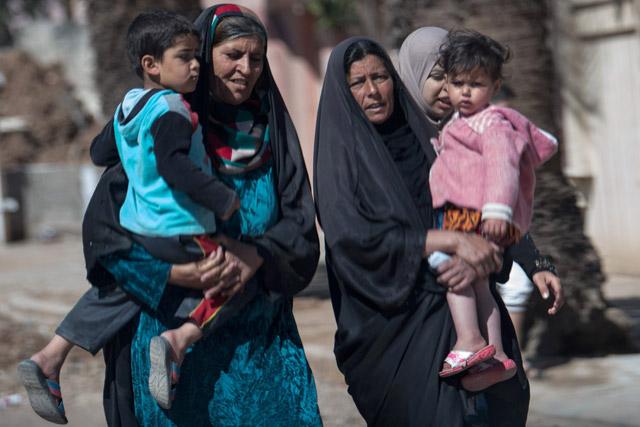You are here
Iraqi forces use siege and stealth against Daesh in Mosul
By Reuters - Apr 25,2017 - Last updated at Apr 25,2017

Iraqis flee west Mosul for a safe area on Tuesday after Iraqi forces retook full control of one of the largest neighbourhoods of west Mosul from Daesh following a week of intense fighting (AFP photo)
MOSUL, Iraq — Iraqi forces are using siege and stealth tactics to drive the Daesh terror group militants out of Mosul's Old City, an Iraqi general said, and minimise harm to civilians trapped in the cramped historic neighbourhood.
Explosions from two car bombs were heard nearby as Lieutenant General Abdul Ghani Al Assadi spoke at his command post on Monday. Thick columns of smoke rose and bursts of heavy gunfire crackled on Tuesday from areas under militant control.
"Most houses in the Old City are very old and its streets and alleyways are very narrow," Assadi, a commander of Iraqi Counter-Terrorism Service (CTS) units in Mosul, told Reuters.
"So to avoid civilian losses we are using siege, but that does not mean we will not enter the Old City."
Assadi said his units do not engage enemy forces in positions where the militants were holding civilians as human shields.
“Using very careful methods and considerations, we will liberate our people from Daesh,” he said.
Government forces have surrounded the militants in the northwestern quarter including the Old City, home to the Grand Al Nuri Mosque, where their leader, Abu Bakr Al Baghdadi, declared a “caliphate” over parts of Iraq and Syria.
The ultra-hardline militants are fighting back using booby traps, suicide motorcycle attacks, sniper and mortar fire and sometimes shells filled with toxic gas.
‘A humanitarian catastrophe’
With food and water becoming scarcer in parts of Mosul still under Daesh control, up to half a million people are believed to be trapped there, including 400,000 in the Old City alone, according to United Nations estimate.
Lise Grande, the UN Humanitarian Coordinator for Iraq, told Reuters last week fighting in the Old City could lead to “a humanitarian catastrophe, perhaps the worst” in the three-year war to evict Daesh from Iraq.
International aid organisations have estimated the civilian and military death toll at several thousand since the US-backed offensive by government forces to retake Mosul began in October. More than 330,000 people have been displaced so far, according to the International Organisation for Migration.
“Humanitarian partners are preparing contingency plans for a number of different displacement scenarios in western Mosul, including for a possible mass outflow of 350,000-450,000 civilians,” the U.N Office for the Coordiation of Humanitarian Affairs said in a report on Tuesday.
Mosul, the largest city in northern Iraq, was captured by Daesh in mid-2014, but government forces have retaken most of it, including the half east of the Tigris River.
The Iraqi military gained additional ground on Tuesday, dislodging the militants from Hay Al Tanak, one of Mosul’s largest districts by area, on the western edge of the city.
Assadi said the battle should end “very soon, God willing” but gave no time frame. “This is a guerrilla war, not a conventional one, so we cannot estimate how long it will take. Daesh is fighting house to house,” he said.
The Iraqi military estimate that 200 to 300 Daesh militants remain in Mosul, mostly foreigners, compared with about 6,000 when the offensive started.
About 500 militants were killed last week, a CTS officer said on Tuesday, without giving casualties among government forces.
The militants “don’t let themselves get captured”, said Assadi. “They came to die and the majority of them are now in hell.”
Related Articles
MOSUL — The Daesh terror group militants shelled areas recaptured by Iraqi forces in western Mosul, hitting civilians fleeing the fighting e
MOSUL, Iraq — Iraqi forces launched an assault Sunday to retake Mosul’s Old City, the last district still held by the Daesh terror gro
MOSUL — Pushing carts loaded with bags, babies and the elderly, hundreds of people fled Mosul on Saturday after Iraqi forces retook tw














